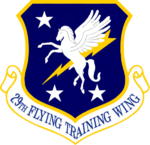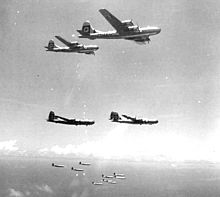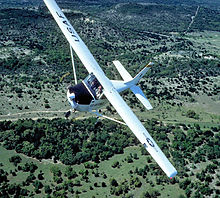29th Flying Training Wing
29th Flying Training Wing
 | |
|---|---|
 T-38 Talonas flown by the 29th Flying Training Wing | |
| Active | 1939–1944; 1944–1946; 1972–1977 |
| Country | |
| Branch | |
| Role | Flying training |
| Motto(s) | Power for Peace |
| Engagements | Pacific Theater of Operations |
| Decorations | Air Force Outstanding Unit Award |
| Insignia | |
| 29th Flying Training Wing emblem(Approved 12 March 1973)[1] |  |
| 29th Bombardment Group emblem(Approved 14 October 1940)[2] |  |
| World War II tail code | Square O |
The29th Flying Training Wingis an inactiveUnited States Air Forceunit last based atCraig Air Force Base,Alabama. It was inactivated when Craig was closed when the Air Force reduced its pilot training program after theVietnam War.
The unit began with itsUnited States Army Air ForcesWorld War IIpredecessor, the29th Bombardment Group.It originally conductedanti-submarine warfareover the Gulf of Mexico during the early years of the war. Later, the 29th was a Replacement Training Unit (RTU). In 1944, the group was reequipped withBoeing B-29 Superfortressesand was engaged in combat as part ofTwentieth Air Force.The 29th Bomb Group's aircraft engaged in very heavy bombardment operations against Japan, during which it earned twoDistinguished Unit Citations.
History[edit]
World War II[edit]
Antisubmarine warfare and heavy bomber training[edit]
Thewingwas first activated atLangley Field,Virginia, as the29th Bombardment Groupin January 1940. with the6th,43dand52d Bombardment Squadronsassigned as its original components.[3][4][5]Its organization was part of the pre-World War IIbuildup of theUnited States Army Air Corpsafter the breakout of war in Europe. In May, it moved toMacDill Field,Florida, where it was equipped with a mix of pre-production YB-17s and early modelBoeing B-17 Flying FortressesandDouglas B-18 Bolos.[2]
In September 1941, thegroupexpanded whan a fourthsquadron,the21st Reconnaissance Squadron,was attached to it.[6]The group was still at MacDill when the Japaneseattacked Pearl Harbor,and it began to flyantisubmarinepatrol missions in the Gulf of Mexico from January 1942.[2]While the group was engaged in antisubmarine patrols, its 21st Reconnaisssance Squadron was renamed the 411th Bombardment Squadron, recognizing that its mission no longer differed from that of the other three squadrons in the group.[6]By the summer of 1942, theU-boatthreat in the Gulf began to diminish, with all German submarines being withdrawn from the area by September.[7]

No longer needed in the Gulf, the group moved toGowen Field,Idaho, where it became anOperational Training Unit(OTU)[2]The OTU program involved the use of an oversized parent unit to providecadresto "satellite groups".[8]The96th,381st,384thand388th Bombardment Groupswere all formed at Gowen in the second half of 1942.[9][10]
In 1943, the 29th Group exchanged its B-17s forConsolidated B-24 Liberators.The group mission also changed as theArmy Air Forces' (AAF) need for new units diminished and its need for replacements increased. The group became aReplacement Training Unit(RTU).[2]Like OTUs, RTUs were oversized units, but their mission was to train individualpilotsandaircrews.However, standard military units, like the 29th Group, were based on relatively inflexibletables of organization,and were not proving well adapted to the training mission. Accordingly, the AAF adopted a more functional system in which each base was organized into a separate numbered unit.[11]The 29th Bombardment Group and its four squadrons were inactivated. Its personnel and equipment, along with that of supporting units at Gowen Field were combined into the 212th AAF Base Unit (Combat Crew Training School, Heavy) on 1 April 1944.[2][12]
Combat in the Pacific[edit]

The AAF was organizing newBoeing B-29 Superfortressvery heavy bombardment units, and the group was activated the same day atPratt Army Air Field,Kansas. The group briefly returned to flying B-17s until B-29s became available for training. In May, The AAF reorganized its very heavy bomber units, and the 411th Bombardment Squadron was inactivated, leaving the group with its original three squadrons.[6]The 29th continued training with the Superfortress until December 1944.[2]Training included long range overwater flights toBorinquen Field,Puerto Rico.[13]
The group deployed toNorth Field, Guam,where it became a component of the314th Bombardment WingofXXI Bomber Command.Its first combat mission was an attack onTokyoon 25 February 1945. Until March 1945, it engaged primarily in daytimehigh altitudeattacks on strategic targets, such as refineries and factories. The campaign against Japan switched that month and the group began to conduct low altitude night raids, usingincendiariesagainst area targets. The group received aDistinguished Unit Citation(DUC) for a 31 March attack against anairfieldatOmura,Japan. The group earned a second DUC in June for an attack on an industrial area ofShizuoka Prefecture,which included an aircraft factory operated byMitsubishiand the ChigusaArsenal.[2]
Staff Sergeant Henry E. "Red" Erwinwas awarded theMedal of Honorfor action that saved his B-29 during a mission overKoriyama,Japan, on 12 April 1945. Sgt Erwin was assigned to job of droppingwhite phosphorus bombsthrough a launching chute in the floor of his bomber. A bomb exploded in the chute and shot back into the plane, severely wounding Sgt Erwin and filling the plane with heavy smoke. Despite being blinded by the burning bomb, he picked it up, carried it forward to the cockpit area of the plane and threw it out an open window. Once the smoke had cleared, the pilot was able to pull the Superfortress out of a dive and recover at an emergency base.[2][14]
DuringOperation Iceberg,the invasion ofOkinawa,the group was diverted from the strategic campaign against Japanese industry and attacked airfields from whichkamikazeattacks were being launched against the landing force. FollowingVJ Day,the group dropped food and supplies to Alliedprisoners of warand participated in severalshow of forcemissions over Japan.[2]It also conducted reconnaissance flights over Japanese cities.[15]The group remained on Guam until it was inactivated in March 1946.[2]
Pilot Training[edit]


The29th Flying Training Wingreplaced, and absorbed resources of, the 3615th Pilot Training Wing on 1 July 1972 atCraig Air Force Base,Alabama. The 29th conducted undergraduate pilot training (UPT) and operated Craig facilities. In 1974, Craig was selected as one of two UPT bases to be closed in a post-Vietnam economic move. In 1977,Air Training Commandclosed Craig Air Force Base along withWebb Air Force Basein Texas. Thewingwas inactivated on 30 September 1977,[1]and the field was placed on caretaker status the next day.
Lineage[edit]
- 29th Bombardment Group
- Constituted as the29th Bombardment Group(Heavy) on 22 December 1939
- Activated on 1 February 1940
- Inactivated on 1 April 1944
- Redesignated29th Bombardment Group,Very Heavy and activated on 1 April 1944
- Inactivated on 20 May 1946[2]
- Consolidated with the29th Flying Training Wingas the29th Flying Training Wingon 31 January 1984[16]
- 29th Flying Training Wing
- Established as the29th Flying Training Wingon 22 March 1972
- Activated on 1 July 1972
- Inactivated on 30 September 1977[1]
- Consolidated with the29th Bombardment Groupon 31 January 1984 (remained inactive)[16]
Assignments[edit]
- General Headquarters Air Force,1 February 1940
- Southeast Air District,21 May 1940
- 3d Bombardment Wing,c. October 1940[17]
- II Bomber Command,25 June 1942 – 1 April 1944
- II Bomber Command, 1 April 1944 (attached to17th Bombardment Operational Training Wingafter c. 15 April 1944)[18]
- 314th Bombardment Wing, 9 November 1944 – 20 May 1946 (attached to 17th Bombardment Operational Training Wing until 17 December 1944)[18][19]
- Air Training Command, 1 July 1972 – 30 September 1977[1]
Components[edit]
- 6th Bombardment Squadron1 February 1940 – 1 April 1944, 1 April 1944 – 20 May 1946[3]
- 43d Bombardment Squadron(later 43d Flying Training Squadron) 1 February 1940 – 1 April 1944; 1 Apr 1944 – 20 May 1946,[4]1 July 1972 – 30 September 1977[1]
- 52d Bombardment Squadron(later 52d Flying Training Squadron) 1 February 1940 – 1 April 1944; 1 Apr 1944 – 20 May 1946,[5]1 July 1972 – 30 September 1977[1]
- 21st Reconnaissance Squadron(later 411th Bombardment Squadron) Attached 5 September 1941, assigned 25 February 1942 – 1 April 1944; 1 April – 10 May 1944[6]
Stations[edit]
- Langley Field, Virginia, 1 February 1940
- MacDill Field, Florida 21 May 1940
- Gowen Field, Idaho 25 June 1942 – 1 April 1944
- Pratt Army Air Field, Kansas 1 April – 7 December 1944
- North Field, Guam, Mariana Islands, 17 January 1945 – 20 May 1946[2]
- Craig Air Force Base, Alabama, 1 July 1972 – 30 September 1977[1]
Aircraft[edit]
- Douglas B-18 Bolo, 1940–1942
- Boeing B-17C Flying Fortress, 1940–1943
- Consolidated B-24 Liberator, 1943–1944
- Boeing B-29 Superfortress, 1944–1946
- Cessna T-37 Tweet,1972–1977
- Northrop T-38 Talon,1972–1977
- Cessna T-41 Mescalero,1972–1973
See also[edit]
- B-17 Flying Fortress units of the United States Army Air Forces
- B-24 Liberator units of the United States Army Air Forces
- List of B-29 Superfortress operators
References[edit]
Notes[edit]
- ^abcdefgRavenstein, p. 54
- ^abcdefghijklmMaurer,Combat Units,pp. 81–82
- ^abMaurer,Combat Squadrons,pp. 145–146
- ^abMaurer,Combat Squadrons,p. 196
- ^abMaurer,Combat Squadrons,p. 219
- ^abcdMaurer,Combat Squadrons,pp. 502–503
- ^Warnock, p. 16
- ^Craven & Cate, Introduction, p. xxxvi
- ^Maurer,Combat Units,pp. 166, 269, 271, 276
- ^"Abstract, History 29 Bombardment Group Nov 1943".Air Force History Index.Retrieved5 June2018.
- ^Goss, p. 75
- ^"Abstract, History Gowen Field, Feb–Mar 1945".Air Force History Index.Retrieved5 June2018.
- ^"Abstract, History 29 Bombardment Group Jan 1945".Air Force History Index.Retrieved6 June2018.
- ^No byline."U.S. Air Force Heritage: Master Sgt. Henry E." Red "Erwin".United States Air Force Public Affairs. Archived fromthe originalon 29 June 2011.Retrieved15 June2018.
- ^"Abstract, History 29 Bombardment Group Aug–Sep 1945".Air Force History Index.Retrieved6 June2018.
- ^abDepartment of the Air Force/MPM Letter 539q, 31 January 1984, Subject: Consolidation of Units
- ^Maurer,Combat Units,pp. 414–415
- ^ab"Factsheet 17 Air Division".Air Force Historical Research Agency. 4 October 2007. Archived fromthe originalon 30 October 2012.Retrieved9 April2014.
- ^"Factsheet 314 Air Division".Air Force Historical Research Agency. 12 October 2007. Archived fromthe originalon 29 September 2012.Retrieved3 March2014.
Bibliography[edit]
![]() This article incorporatespublic domain materialfrom theAir Force Historical Research Agency
This article incorporatespublic domain materialfrom theAir Force Historical Research Agency
- Craven, Wesley F; Cate, James L, eds. (1955).The Army Air Forces in World War II(PDF).Vol. VI, Men & Planes. Chicago, IL: University of Chicago Press.LCCN48003657.OCLC704158.Retrieved17 December2016.
- Goss, William A. (1955). "The Organization and its Responsibilities, Chapter 2 The AAF". In Craven, Wesley F.; Cate, James L. (eds.).The Army Air Forces in World War II(PDF).Vol. VI, Men & Planes. Chicago, IL: University of Chicago Press.LCCN48003657.OCLC704158.Retrieved17 December2016.
- Maurer, Maurer, ed. (1983) [1961].Air Force Combat Units of World War II(PDF)(reprint ed.). Washington, DC: Office of Air Force History.ISBN0-912799-02-1.LCCN61060979.
- Maurer, Maurer, ed. (1982) [1969].Combat Squadrons of the Air Force, World War II(PDF)(reprint ed.). Washington, DC: Office of Air Force History.ISBN0-405-12194-6.LCCN70605402.OCLC72556.
- Ravenstein, Charles A. (1984).Air Force Combat Wings, Lineage & Honors Histories 1947–1977.Washington, DC: Office of Air Force History.ISBN0-912799-12-9.
- Warnock, Timothy."The Battle Against the U-Boat in the American Theater"(PDF).Bolling AFB, DC: Air Force History Support Office. Archived fromthe original(PDF)on 7 March 2014.Retrieved22 June2015.





